Chapter 08 Mechanical Properties of Solids
Multiple Choice Questions (MCQs)
1. Modulus of rigidity of ideal liquids is
(a) infinity
(b) zero
(c) unity
(d) some finite small non-zero constant value
Show Answer
Answer (b) No frictional (viscous) force exists in case of ideal fluid, hence, tangential forces are zero so there is no stress developed.2. The maximum load a wire can withstand without breaking, when its length is reduced to half of its original length, will
(a) be double
(b) be half
(c) be four times
(d) remain same
Show Answer
Answer (d) We know that, Breaking stress $=\frac{\text { Breaking force }}{\text { Area of cross-section }}$
When length of the wire changes, area of cross-section remains same.
Hence, breaking force will be same when length changes.
3. The temperature of a wire is doubled. The Young’s modulus of elasticity
(a) will also double
(b) will become four times
(c) will remain same
(d) will decrease
Show Answer
Answer (d) We know that with increase in temperature length of a wire changes as
$$ L_{t}=L_{o}(1+\alpha \Delta T) $$
where $\Delta T$ is change in the temperature, $L_0$ is original length, $\alpha$ is coefficient of linear expansion and $L_{t}$ is Length at temperature $T$.
Now we can write
$$ \Delta L=L_{t}-L_0=L_0 \alpha \Delta T $$
where $\alpha$ is coefficient of linear expansion.
Young’s modulus $(Y)=\frac{\text { Stress }}{\text { Strain }}=\frac{F L_0}{A \times \Delta L}=\frac{F L_0}{A L_0 \alpha \Delta T} \propto \frac{1}{\Delta T}$
As,
$$ Y \propto \frac{1}{\Delta T} $$
When temperature increases $\Delta T$ increases, hence, $Y$ decreases.
4. A spring is stretched by applying a load to its free end. The strain produced in the spring is
(a) volumetric
(b) shear
(c) longitudinal and shear
(d) longitudinal
Show Answer
Answer (c) Consider the diagram where a spring is stretched by applying a load to its free end. Clearly the length and shape of the spring changes.
The change in length corresponds to longitudinal strain and change in shape corresponds to shearing strain.
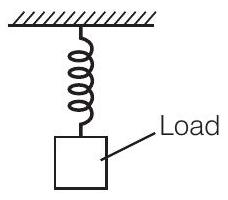
5. A rigid bar of mass $M$ is supported symmetrically by three wires each of length $l$. Those at each end are of copper and the middle one is of iron. The ratio of their diameters, if each is to have the same tension, is equal to
(a) $Y_{\text {copper }} / Y_{\text {iron }}$
(b) $\sqrt{\frac{Y_{\text {iron }}}{Y_{\text {copper }}}}$
(c) $\frac{Y^{2} \text { iron }}{Y^{2} \text { copper }}$
(d) $\frac{Y_{\text {iron }}}{Y_{\text {copper }}}$
Show Answer
Answer (b) We know that Young’s modulus
$$ \begin{aligned} & Y=\frac{\text { Stress }}{\text { Strain }}=\frac{F / A}{\Delta L / L}=F / A \times \frac{L}{\Delta L} \\ &=\frac{F}{\pi(D / 2)^{2}} \times \frac{L}{\Delta L}=\frac{4 F L}{\pi D^{2} \Delta L} \\ & \Rightarrow \quad D^{2}=\frac{4 F L}{\pi \Delta L Y} \Rightarrow D=\sqrt{\frac{4 F L}{\pi \Delta L Y}} \\ & \text { As } F \text { and } \frac{L}{\Delta L} \text { are constants. } \end{aligned} $$
Hence,
$$ D \propto \sqrt{\frac{1}{Y}} $$
Now, we can find ratio as $\frac{D_{\text {copper }}}{D_{\text {iron }}}=\sqrt{\frac{Y_{\text {iron }}}{Y_{\text {copper }}}}$
6. A mild steel wire of length $2 L$ and cross-sectional area $A$ is stretched, well within elastic limit, horizontally between two pillars (figure). A mass $m$ is suspended from the mid-point of the wire. Strain in the wire is
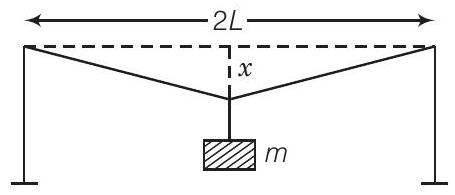
(a) $\frac{x^{2}}{2 L^{2}}$
(b) $\frac{x}{L}$
(c) $x^{2} / L$
(d) $x^{2} / 2 L$
Show Answer
Thinking Process
We will assume the vertical displacement $x$ to be very small compared to $L$. . Change in the length will be calculated by difference of final total length and initial length $2 L$.
Answer (a) Consider the diagram below
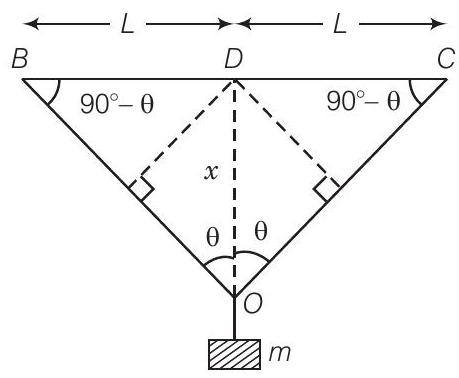
Hence, change in length
$$ \begin{matrix} \Delta L & =B O+O C-(B D+D C) & \\ & =2 B O-2 B D \\ & =2[B O-B D] \\ & =2[(x^{2}+L^{2})^{1 / 2}-L] \\ & =2 L[(1+\frac{x^{2}}{L^{2}})^{1 / 2}-1] \\ & \approx 2 L[1+\frac{1}{2} \frac{x^{2}}{L^{2}}-1]=\frac{x^{2}}{L} & \\ \therefore \quad \text { Strain } & =\frac{\Delta L}{2 L}=\frac{x^{2} / L}{2 L}=\frac{x^{2}}{2 L^{2}} & {[\because x«L]} \end{matrix} $$
7. A rectangular frame is to be suspended symmetrically by two strings of equal length on two supports (figure). It can be done in one of the following three ways;
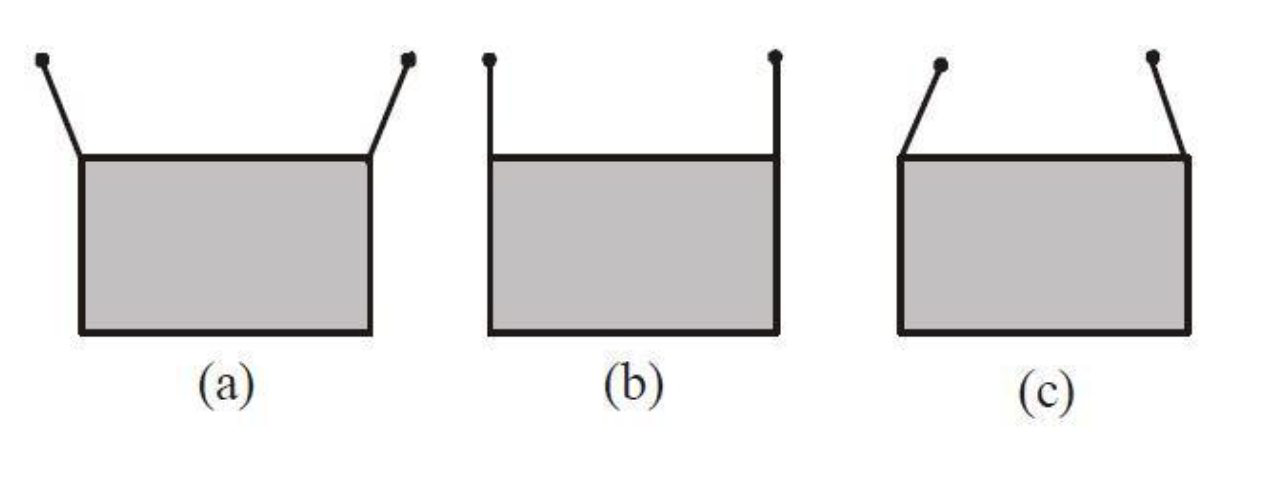
The tension in the strings will be
(a) the same in all cases
(b) least in (a)
(c) least in (b)
(d) least in (c)
Show Answer
Answer (c) Consider the FBD diagram of the rectangular frame
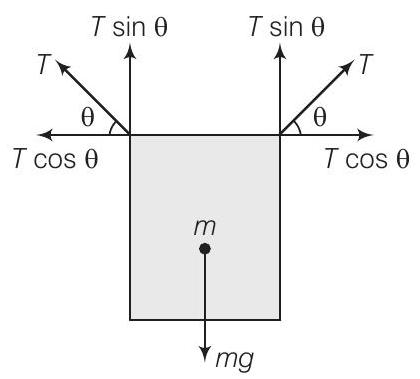
Balancing vertical forces $2 T \sin \theta-m g=0 $
$2 T \sin \theta=m g $
Total horizontal force $=T \cos \theta-T \cos \theta=0$
Now from Eq. (i), $\quad T=\frac{m g}{2 \sin \theta}$
As $m g$ is constant
$$ \begin{aligned} \Rightarrow \quad T \propto \frac{1}{\sin \theta} & \Rightarrow T_{\max }=\frac{m g}{2 \sin \theta_{\text {min }}} \\ \sin \theta_{\text {min }}=0 & \Rightarrow \theta_{\text {min }}=0 \end{aligned} $$
No option matches with $\theta=0^{\circ}$
$$ \begin{aligned} & T_{\min }=\frac{m g}{2 \sin \theta_{\max }} \\ & \sin \theta_{\max }=1 \Rightarrow \theta=90^{\circ} \\ & (\text { since, } \sin \theta_{\max }=1) \end{aligned} $$
Matches with option (b)
Hence, tension is least for the case (b).
Note We should be careful when measuring the angle, it must be in the direction as given in the diagram.
8. Consider two cylindrical rods of identical dimensions, one of rubber and the other of steel. Both the rods are fixed rigidly at one end to the roof. A mass $M$ is attached to each of the free ends at the centre of the rods.
(a) Both the rods will elongate but there shall be no perceptible change in shape
(b) The steel rod will elongate and change shape but the rubber rod will only elongate
(c) The steel rod will elongate without any perceptible change in shape, but the rubber rod will elongate and the shape of the bottom edge will change to an ellipse
(d) The steel rod will elongate, without any perceptible change in shape, but the rubber rod will elongate with the shape of the bottom edge tapered to a tip at the centre
Show Answer
Answer (d) Consider the diagram.
A mass $M$ is attached at the centre. As the mass is attached to both the rods, both rod will be elongated, but due to different elastic properties of material rubber changes shape also.
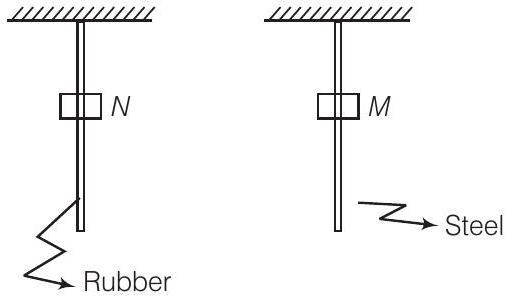
Multiple Choice Questions (More Than One Options)
9. The stress-strain graphs for two materials are shown in figure. (assume same scale)
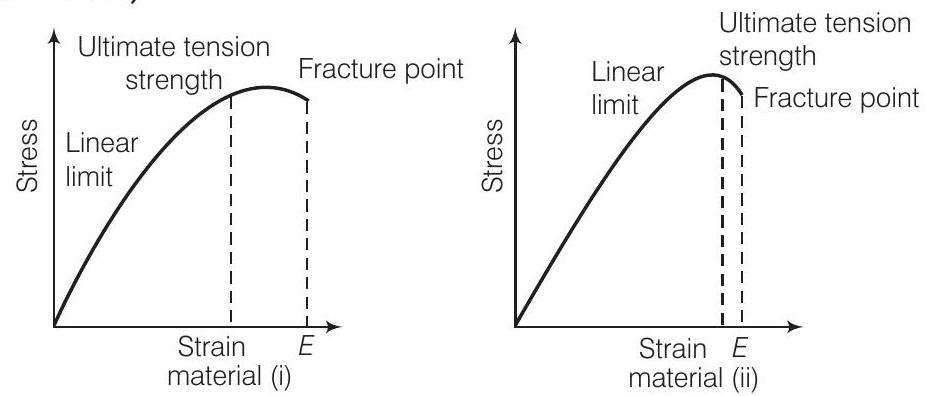
(a) Material (ii) is more elastic than material (i) and hence material (ii) is more brittle
(b) Material (i) and (ii) have the same elasticity and the same brittleness
(c) Material (ii) is elastic over a larger region of strain as compared to (i)
(d) Material (ii) is more brittle than material (i)
Show Answer
Thinking Process
We have to compare ultimate tensile strength for each material. Material having more ultimate tensile strength will be elastic over larger region.
Answer (c, $d)$
It is clear from the two graphs, the ultimate tensile strength for material (ii) is greater, hence material(ii) is elastic over larger region as compared to material (i). For material(ii) fracture point is nearer, hence it is more brittle.
10. A wire is suspended from the ceiling and stretched under the action of a weight $F$ suspended from its other end. The force exerted by the ceiling on its is equal and opposite to the weight.
(a) Tensile stress at any cross-section $A$ of the wire is $F / A$
(b) Tensile stress at any cross-section is zero
(c) Tensile stress at any cross-section $A$ of the wire is $2 F / A$
(d) Tension at any cross-section $A$ of the wire is $F$
Show Answer
Answer $(a, d)$
As shown in the diagram
Clearly, forces at each cross-section is $F$.
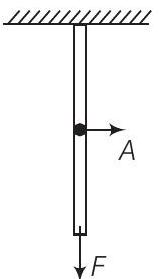
Now applying formula,
$$ \begin{aligned} \text { Stress } & =\frac{\text { Tension }}{\text { Area }}=\frac{F}{A} \\ \text { Tension } & =\text { Applied force }=F \end{aligned} $$
11. A rod of length $l$ and negligible mass is suspended at its two ends by two wires of steel (wire $A$ ) and aluminium (wire $B$ ) of equal lengths (figure). The cross-sectional areas of wires $A$ and $B$ are $1.0 mm^{2}$ and $2.0 mm^{2}$, respectively. $\quad(Y_{A l}=70 \times 10^{9} Nm^{-2}.$ and $.Y_{\text {steel }}=200 \times 10^{9} Nm^{-2})$
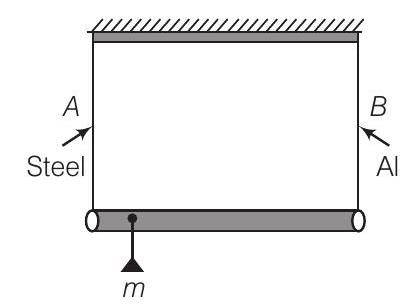
(a) Mass $m$ should be suspended close to wire $A$ to have equal stresses in both the wires
(b) Mass $m$ should be suspended close to $B$ to have equal stresses in both the wires
(c) Mass $m$ should be suspended at the middle of the wires to have equal stresses in both the wires
(d) Mass $m$ should be suspended close to wire $A$ to have equal strain in both wires
Show Answer
Answer $(b, d)$
Let the mass is placed at $x$ from the end $B$.
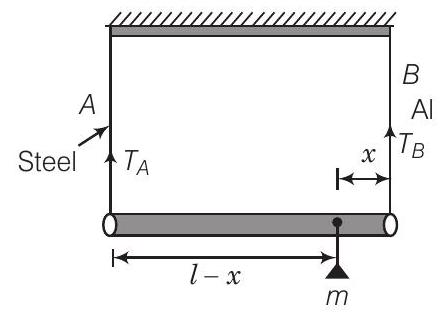
Let $T_{A}$ and $T_{B}$ be the tensions in wire $A$ and wire $B$ respectively.
For the rotational equilibrium of the system,
$$ \begin{aligned} & \sum \tau=0 \\ & \Rightarrow \quad T_{B} x-T_{A}(l-x)=0 \\ & \Rightarrow \quad \frac{T_{B}}{T_{A}}=\frac{l-x}{x} \\ & \text { Stress in wire } A=S_{A}=\frac{T_{A}}{a_{A}} \\ & \text { Stress in wire } B=S_{B}=\frac{T_{B}}{a_{B}} \end{aligned} $$
where $a_{A}$ and $a_{B}$ are cross-sectional areas of wire $A$ and $B$ respectively.
By question $a_{B}=2 a_{A}$
Now, for equal stress
$$ \begin{aligned} & \Rightarrow \quad \frac{T_{A}}{a_{A}}=\frac{T_{B}}{a_{B}} \Rightarrow \frac{T_{B}}{T_{A}}=\frac{a_{B}}{a_{A}}=2 \\ & \Rightarrow \quad \frac{l-x}{x}=2 \Rightarrow \frac{l}{x}-1=2 \\ & \Rightarrow \quad x=\frac{l}{3} \Rightarrow l-x=l-l / 3=\frac{2 l}{3} \end{aligned} $$
Hence, mass $m$ should be placed closer to $B$.
For equal strain, $\quad( strain )_A $= $( strain)_B $
$ \Rightarrow \quad \frac{(Y_{A})}{S_{A}}=\frac{Y_{B}}{S_{B}} \quad \text { (where } Y_{A} \text { and } Y_{B} \text { are Young modulii) } $
$ \Rightarrow \quad \frac{Y_{\text {steel }}}{T_{A} / a_{A}}=\frac{Y_{A l}}{T_{B} / a_{B}} $
$ \Rightarrow \quad \frac{Y_{\text {steel }}}{Y_{\text {Al }}}=\frac{T_{A}}{T_{B}} \times \frac{a_{B}}{a_{A}}=(\frac{x}{l-x})(\frac{2 a_{A}}{a_{A}}) $
$ \Rightarrow \quad \frac{200 \times 10^{9}}{70 \times 10^{9}}=\frac{2 x}{l-x} \Rightarrow \frac{20}{7}=\frac{2 x}{l-x} $
$ \Rightarrow \quad \frac{10}{7}=\frac{x}{l-x} \Rightarrow 10 l-10 x=7 x $
$ \Rightarrow \quad 17 x=10 l \quad \Rightarrow \quad x=\frac{10 l}{17} $
$ l-x=l-\frac{10 l}{17}=\frac{7 l}{17}$
Hence, mass $m$ should be placed closer to wire $A$.
12. For an ideal liquid,
(a) the bulk modulus is infinite
(b) the bulk modulus is zero
(c) the shear modulus is infinite
(d) the shear modulus is zero
Show Answer
Answer $(a, d)$
As an ideal liquid is not compressible.
Hence, change in volume, $\quad \Delta V=0$
$$ \begin{aligned} & \text { Bulk modulus } B=\frac{\text { Stress }}{\text { Volume strain }}=\frac{F / A}{\Delta V / V}=\frac{F}{A} \times \frac{V}{\Delta V}=\infty \\ & \text { Compressibility, } K=\frac{1}{B}=\frac{1}{\infty}=0 \end{aligned} $$
As there is no tangential (viscous) force exists in case of an ideal fluid, hence, shear modulus $=0$.
13. A copper and a steel wire of the same diameter are connected end to end. A deforming force $F$ is applied to this composite wire which causes a total elongation of $1 cm$. The two wires will have
(a) the same stress
(b) different stress
(c) the same strain
(d) different strain
Show Answer
Answer $(a, d)$
Consider the diagram where a deforming force $F$ is applied to the combination.
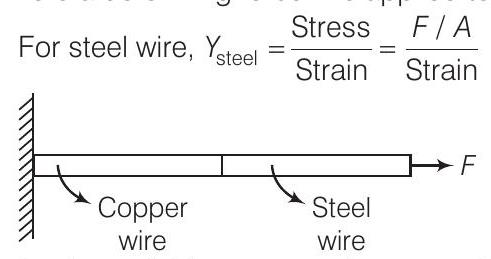
where $F$ is tension in each wire and $A$ is cross-section area of each wires.
As $F$ and $A$ are same for both the wire, hence, stress will be same for both the wire.
As,
$( Strain )_{steel } $ = $\frac{ Stress }{Y _ {steel }} $,
$(Strain ) _ {copper} $= $\frac{ Stress }{Y _ {copper }} $
$Y_{\text {steel }} \neq Y_{\text {copper }}$
Hence, the two wires will have differents strain.
Very Short Answer Type Questions
14. The Young’s modulus for steel is much more than that for rubber. For the same longitudinal strain, which one will have greater tensile stress?
Show Answer
Answer Young’s modulus $(Y)=\frac{\text { Stress }}{\text { Longitudinal strain }}$
For same longitudinal strain,
But
$\therefore$
$Y \propto \text { stress }$
$\frac{Y _ {\text {steel }}}{Y _ {\text {rubber }}} =\frac{(\text { stress }) _ {\text {steel }}}{(\text { stress }) _ {\text {rubber }}}$
Therefore, from Eq. (i),
$ \frac{(\text { stress }) _ {\text {steel }}}{(\text { stress }) _ {\text {rubber }}}>1 $ $ \Rightarrow \quad(\text { stress }) _ {\text {steel }}>\text { (stress) } _ {\text {rubber }}$
15. Is stress a vector quantity?
Show Answer
Answer Stress $=\frac{\text { Magnitude of internal reaction force }}{\text { Area of cross }- \text { section }}$
Therefore, stress is a scalar quantity not a vector quantity.
16. Identical springs of steel and copper are equally stretched. On which, more work will have to be done?
Show Answer
Answer Work done in stretching a wire is given by $W=\frac{1}{2} F \times \Delta l$
[where $F$ is applicd force and $\Delta l$ is extension in the wire] As springs of steel and copper are equally stretched. Therefore, for same force $(F)$,
$$ W \propto \Delta l $$
$$ \text { Young’s modulus }(Y)=\frac{F}{A} \times \frac{l}{\Delta l} \Rightarrow \Delta l=\frac{F}{A} \times \frac{l}{Y} $$
As both springs are identical, $\quad \Delta l \propto \frac{1}{Y}$
From Eqs. (i) and (ii), we get $\quad W \propto \frac{1}{Y}$
$$ \begin{matrix} \therefore & \frac{W_{\text {steel }}}{W_{\text {copper }}}=\frac{Y_{\text {copper }}}{Y_{\text {steel }}}<1 & \text { (As, } .Y_{\text {steel }}>Y_{\text {copper }}) \\ \Rightarrow & W_{\text {steel }}<W_{\text {copper }} \end{matrix} $$
Therefore, more work will be done for stretching copper spring.
17. What is the Young’s modulus for a perfect rigid body?
Show Answer
Answer Young’s modulus $(Y)=\frac{F}{A} \times \frac{l}{\Delta l}$
For a perfectly rigid body, change in length $\Delta l=0$
$$ Y=\frac{F}{A} \times \frac{l}{0}=\infty $$
Therefore, Young’s modulus for a perfectly rigid body is infinite( $(\infty)$.
18. What is the Bulk modulus for a perfect rigid body?
Show Answer
Answer Bulk modulus $(K)=\frac{p}{\Delta V / V}=\frac{p V}{\Delta V}$
For perfectly rigid body, change in volume $\Delta V=0$
$\therefore \quad K=\frac{p V}{0}=\infty$
Therefore, bulk modulus for a perfectly rigid body is infinity $(\infty)$.
19. A wire of length $L$ and radius $r$ is clamped rigidly at one end. When the other end of the wire is pulled by a force $f$, its length increases by $l$. Another wire of the same material of length $2 L$ and radius $2 r$, is pulled by a force $2 f$. Find the increase in length of this wire.
Show Answer
Thinking Process
In this problem, we have to apply Hooke’s law and then elongation in each wire will be compared.
Answer The situation is shown in the diagram.
Now, $\quad$ Young’s modulus $(Y)=\frac{f}{A} \times \frac{L}{l}$
For first wire,
$Y=\frac{f}{\pi r^{2}} \times \frac{L}{l}$
For second wire,
$Y=\frac{2 f}{\pi(2 r)^{2}} \times \frac{2 L}{l^{\prime}}$
$=\frac{f}{\pi r^{2}} \times \frac{L}{l^{\prime}}$
From Eqs. (i) and (ii),
$$
\frac{f}{\pi r^{2}} \times \frac{L}{l}=\frac{f}{\pi r^{2}} \times \frac{L}{l^{\prime}}
$$
$$
l=l^{\prime}
$$

( $\because$ Both wires are of same material, hence, Young’s modulus will be same.)
20. A steel $rod(Y=2.0 \times 10^{11} N / m^{2}.$ and $.\alpha=10^{-50}{ }^{\circ} C^{-1})$ of length $1 m$ and area of cross-section $1 cm^{2}$ is heated from $0^{\circ} C$ to $200^{\circ} C$, without being allowed to extend or bend. What is the tension produced in the rod?
Show Answer
Thinking Process
Due to increase in temperature of the rod, length, increases. The equation of thermal expansion for linear expansion will be applied.
Answer Given, Young’s modulus of steel $Y=2.0 \times 10^{11} N / m^{2}$
Coefficient of thermal expansion $\alpha=10^{-5}{ }^{\circ} C^{-1}$
Length $l=1 m$
Area of cross-section $A=1 cm^{2}=1 \times 10^{-4} m^{2}$
Increase in temperature $\Delta t=200^{\circ} C-0^{\circ} C=200^{\circ} C$
Tension produced in steel rod $(F)=Y A \alpha \Delta t$
$$ \begin{aligned} & =2.0 \times 10^{11} \times 1 \times 10^{-4} \times 10^{-5} \times 200 \\ & =4 \times 10^{4} N \end{aligned} $$
21. To what depth must a rubber ball be taken in deep sea so that its volume is decreased by $0.1 %$. (The bulk modulus of rubber is $9.8 \times 10^{8} N / m^{2}$; and the density of sea water is $10^{3} kg / m^{3}$ )
Show Answer
Answer Given, Bulk modulus of rubber $(K)=9.8 \times 10^{8} N / m^{2}$
Density of sea water $(\rho)=10^{3} kg / m^{3}$
Percentage decrease in volume, $(\frac{\Delta V}{V} \times 100)=0.1 \Rightarrow \frac{\Delta V}{V}=\frac{0.1}{100}$
$\Rightarrow \quad \frac{\Delta V}{V}=\frac{1}{1000}$
Let the rubber ball be taken upto depth $h$.
$\therefore \quad$ Change in pressure $(p)=h \rho g$
$\therefore \quad$ Bulk modulus $(K)=|\frac{p}{\Delta V / V}|=\frac{h \rho g}{(\Delta V / V)}$
$\Rightarrow \quad h=\frac{K \times(\Delta V / V)}{\rho g}=\frac{9.8 \times 10^{8} \times \frac{1}{1000}}{10^{3} \times 9.8}=100 m$
22. A truck is pulling a car out of a ditch by means of a steel cable that is $9.1 m$ long and has a radius of $5 mm$. When the car just begins to move, the tension in the cable is $800 N$. How much has the cable stretched? (Young’s modulus for steel is $2 \times 10^{11} N / m^{2}$ )
Show Answer
Answer
$$ \begin{aligned} \text { Length of steel cable } l & =9.1 m \\ \text { Radius } r & =5 mm=5 \times 10^{-3} m \\ \text { Tension in the cable } F & =800 N \\ \text { Young’s modulus for steel } Y & =2 \times 10^{11} N / m^{2} \\ \text { Change in length } \Delta l & =? \\ \text { Young’s modulus }(Y) & =\frac{F}{A} \times \frac{l}{\Delta l} \Rightarrow \Delta l=\frac{F}{\pi r^{2}} \times \frac{l}{Y} \\ & =\frac{800}{3.14 \times(5 \times 10^{-3})^{2}} \times \frac{9.1}{2 \times 10^{11}} \\ & =4.64 \times 10^{-4} m \end{aligned} $$
23. Two identical solid balls, one of ivory and the other of wet-clay, are dropped from the same height on the floor. Which one will rise to a greater height after striking the floor and why?
Show Answer
Answer Since, ivory ball is more elastic than wet-clay ball, therefore, ivory ball tries to regain its original shape quickly. Hence, more energy and momentum is transferred to the ivory ball in comparison to the wet clay ball and therefore, ivory ball will rise higher after striking the floor.24. Consider a long steel bar under a tensile stress due to forces $F$ acting at the edges along the length of the bar (figure). Consider a plane making an angle $\theta$ with the length. What are the tensile and shearing stresses on this plane?
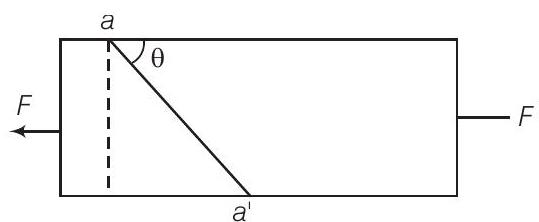
(a) For what angle is the tensile stress a maximum?
(b) For what angle is the shearing stress a maximum?
Show Answer
Thinking Process
To solve this question, we have to resolve the force along and perpendicular to the inclined plane. Now, we can easily calculate the tensile and shearing stress.
Answer Consider the adjacent diagram.
Let the cross-sectional area of the bar be $A$. Consider the equilibrium of the plane aa’. A force $F$ must be acting on this plane making an angle $\frac{\pi}{2}-\theta$ with the normal $O N$. Resolving $F$ into components, along the plane $(F P)$ and normal to the plane.
$$ \begin{aligned} & F_{P}=F \cos \theta \\ & F_{N}=F \sin \theta \end{aligned} $$
Let the area of the face aa’ be $A^{\prime}$, then
$$ \begin{aligned} \frac{A}{A^{\prime}} & =\sin \theta \\ \therefore \quad \text { The tensile stress } & =\frac{A}{\sin \theta} \\ & =\frac{\text { Normal force }}{A / \sin \theta}=\frac{F \sin \theta}{A^{\prime}} \\ \text { Shearing stress } & =\frac{\text { Parallel force }}{\text { Area }} \\ & =\frac{F \cos \theta}{A / \sin \theta}=\frac{F}{A} \sin \theta \cdot \cos \theta \\ & =\frac{F}{2 A}(2 \sin \theta \cdot \cos \theta)=\frac{F}{2 A} \sin 2 \theta \end{aligned} $$
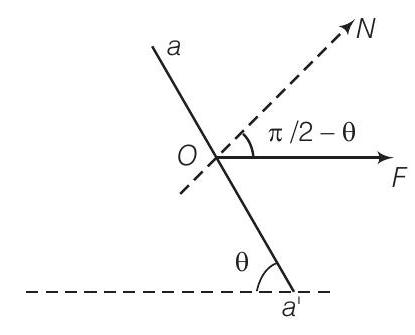
(a) For tensile stress to be maximum, $\sin ^{2} \theta=1$
$$ \begin{aligned} \Rightarrow & \sin \theta & =1 \\ \Rightarrow & \theta & =\frac{\pi}{2} \end{aligned} $$
(b) For shearing stress to be maximum,
$$ \begin{matrix} \Rightarrow & & \sin 2 \theta & =1 \\ \Rightarrow & 2 \theta & =\frac{\pi}{2} \\ \Rightarrow & & \theta & =\frac{\pi}{4} \end{matrix} $$
Note We must not apply the formula for stress directly, forces must be resolved.
25. (a) A steel wire of mass $\mu$ per unit length with a circular cross-section has a radius of $0.1 cm$. The wire is of length $10 m$ when measured lying horizontal, and hangs from a hook on the wall. A mass of $25 kg$ is hung from the free end of the wire. Assuming, the wire to be uniform and lateral strains $<$ longitudinal strains, find the extension in the length of the wire. The density of steel is $7860 kg m^{-3}$. (Young’s modulus $Y=2 \times 10^{11} Nm^{-2}$.
(b) If the yield strength of steel is $2.5 \times 10^{8} Nm^{-2}$, what is the maximum weight that can be hung at the lower end of the wire?
Show Answer
Thinking Process
When the wire is hanging different part of the wire will be acted upon by different forces. To find the tension due to whole wire, consider a small element and find the tension there and then integrate for the whole wire.
Answer Consider the diagram when a small element of length $d x$ is considered at $x$ from the load $(x=0)$.
(a) Let $T(x)$ and $T(x+d x)$ are tensions on the two cross-sections a distance $d x$ apart, then-$-T(x+d x)+T(x)=d m g=\mu d x g$ (where $\mu$ is the mass/length).
$(\because d m=\mu d x)$
$$ \begin{matrix} \Rightarrow & & T(x) & =\mu g x+C \\ \text { At } x=0, T(0)=M g \Rightarrow & C & =M g \\ \therefore & & T(x) & =\mu g x+M g \end{matrix} $$
Let the length $d x$ at $x$ increase by $d r$, then
$$ \begin{aligned} \text { Young’s modulus } Y & =\frac{\text { Stress }}{\text { Strain }} \\ \frac{T(x) / A}{d r / d x} & =Y \\ \Rightarrow \quad \frac{d r}{d x} & =\frac{1}{Y A} T(x) \\ r & =\frac{1}{Y A} \int_0^{L}(\mu g x+M g) d x \\ & =\frac{1}{Y A}[\frac{\mu g x^{2}}{2}+M g x]_0^{L} \\ & =\frac{1}{Y A}[\frac{m g L^{2}}{2}+M g L] \end{aligned} $$
$$ \begin{matrix} {[\because d T=T(x+d x)-T(x)]} \\ \text { (on integrating) } \end{matrix} $$
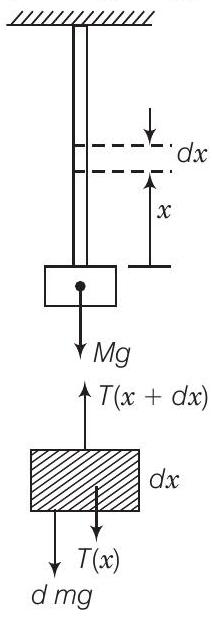
( $m$ is the mass of the wire)
$$ A=\pi \times(10^{-3})^{2} m^{2} $$
$$ \begin{aligned} & Y=200 \times 10^{9} Nm^{-2} \\ & m=\pi \times(10^{-3})^{2} \times 10 \times 7860 kg \end{aligned} $$
$$ \begin{aligned} \therefore \quad r & =\frac{1}{2 \times 10^{11} \times \pi \times 10^{-6}} \quad[\frac{\pi \times 786 \times 10^{-3} \times 10 \times 10}{2}+25 \times 10 \times 10] \\ & =[196.5 \times 10^{-6}+3.98 \times 10^{-3}] \approx 4 \times 10^{-3} m \end{aligned} $$
(b) Clearly tension will be maximum at $x=L$
$$\therefore T =\mu g L+M g=(m+M) g$$
$$ \text{The yield force =(Yield strength Y) area} =250 \times 10^{6} \times \pi \times(10^{-3})^{2}=250 \times \pi N$$
$$ \text{At yield point} \quad[\because m=\mu L]$$
$$\Rightarrow \quad(m+M) g =250 \times \pi$$
$$\Rightarrow m =\pi \times(10^{-3})^{2} \times 10 \times 7860 \ll M$$
$$\therefore M g \approx 250 \times \pi$$
$$\text{Hence}, M =\frac{250 \times \pi}{10}=25 \times \pi \approx 75 kg$$.
26. A steel rod of length $2 l$, cross-sectional area $A$ and mass $M$ is set rotating in a horizontal plane about an axis passing through the centre. If $Y$ is the Young’s modulus for steel, find the extension in the length of the rod. (assume the rod is uniform)
Show Answer
Thinking Process
To solve this question, we have to consider a small element, find tension in the rod at this element and then calculate for the whole rod.
Answer Consider an element of width $d r$ at $r$ as shown in the diagram. Let $T(r)$ and $T(r+d r)$ be the tensions at $r$ and $r+d r$ respectively.
Net centrifugal force on the element $=\omega^{2} r d m$
(where $\omega$ is angular velocity of the rod)
$$ \begin{aligned} & =\omega^{2} r \mu d r \\ & \Rightarrow \quad T(r)-T(r+d r)=\mu \omega^{2} r d r \\ & \Rightarrow \quad-d T=\mu \omega^{2} r d r \\ & {[\because \text { Tension and centrifugal forces are opposite] }} \\ & \therefore \quad-\int_{T=0}^{T} d T=\int_{r=l}^{r=r} \mu \omega^{2} r d r \quad[\because T=0 \text { at } r=l] \\ & \Rightarrow \quad T(r)=\frac{\mu \omega^{2}}{2}(l^{2}-r^{2}) \end{aligned} $$
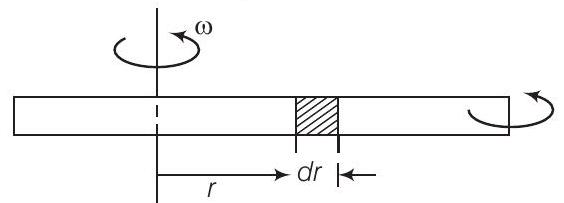
Let the increase in length of the element $d r$ be $\Delta r$
$$ \begin{aligned} & \text { So, } \quad \text { Young’s modulus } Y=\frac{\text { Stress }}{\text { Strain }}=\frac{T(r) / A}{\frac{\Delta r}{d r}} \\ & \therefore \quad \frac{\Delta r}{d r}=\frac{T(r)}{A}=\frac{\mu \omega^{2}}{2 Y A}(l^{2}-r^{2}) \\ & \therefore \quad \Delta r=\frac{1}{Y A} \frac{\mu \omega^{2}}{2}(l^{2}-r^{2}) d r \\ & \therefore \quad \Delta=\text { change in length in right part }=\frac{1}{Y A} \frac{\mu \omega^{2}}{2} \int_0^{l}(l^{2}-r^{2}) d r \\ & =(\frac{1}{Y A}) \frac{\mu \omega^{2}}{2}[l^{3}-\frac{l^{3}}{3}]=\frac{1}{3 Y A} \mu \omega^{2} L^{2} \\ & \therefore \quad \text { Total change in length }=2 \Delta=\frac{2}{3 Y A} \mu \omega^{2} l^{2} \end{aligned} $$

27. An equilateral triangle $A B C$ is formed by two Cu rods $A B$ and $B C$ and one Al rod. It is heated in such a way that temperature of each rod increases by $\triangle T$. Find change in the angle $A B C$. [Coeffecient of linear expansion for $Cu$ is $\alpha_1$, coefficient of linear expansion for $Al$ is $\alpha_2$ ]
Show Answer
Thinking Process
Due to increase in temperature length of each side will change, hence, the angle corresponding to any vertex also changes.
Answer Consider the diagram shown
Let
$$ \begin{aligned} l_1 & =A B, l_2=A C, l_3=B C \\ \cos \theta & =\frac{l_3^{2}+l_1^{2}-l_2^{2}}{2 l_3 l_1} \end{aligned} $$
$$ \Rightarrow \quad 2 l_3 l_1 \cos \theta=l_3^{2}+l_1^{2}-l_2^{2} $$
Differentiating $2(l_3 d l_1+l_1 d l_3) \cos \theta-2 l_1 l_3 \sin \theta d \theta$
(assume $\angle A B C=\theta$ )
Now,
and
$$ =2 l_3 d l_1+2 l_1 d l_1-2 l_2 d l_2 $$
$d l_1=l_1 \alpha_1 \Delta t \quad$ (where, $\Delta t=$ change in temperature)
$d l_2=l_2 \alpha_1 \Delta t \Rightarrow d l_3=l_3 \alpha_2 \Delta t$
$l_1=l_2=l_3=l$
$(l^{2} \alpha_1 \Delta t+l^{2} \alpha_1 \Delta t) \cos \theta+l^{2} \sin \theta d \theta=l^{2} \alpha_1 \Delta t+l^{2} \alpha_1 \Delta t-l^{2} \alpha_2 \Delta t$
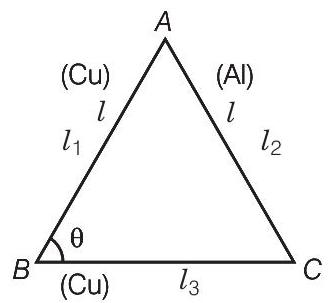
Putting
$$ \sin \theta d \theta=2 \alpha_1 \Delta t(1-\cos \theta)-\alpha_2 \Delta t $$
$$ \theta=60^{\circ} $$
(for equilateral triangle)
$$ d \theta \times \sin 60^{\circ}=2 \alpha_1 \Delta t(1-\cos 60^{\circ})-\alpha_2 \Delta t $$
$$ =2 \alpha_1 \Delta t \times \frac{1}{2}-\alpha_2 \Delta t=(\alpha_1-\alpha_2) \Delta t $$
$\Rightarrow \quad d \theta=$ change in the angle $\angle A B C$
$$ =\frac{(\alpha_1-\alpha_2) \Delta T}{\sin 60^{\circ}}=\frac{2(\alpha_1-\alpha_2) \Delta T}{\sqrt{3}} \quad(\because \Delta t=\Delta T \text { given }) $$
28. In nature, the failure of structural members usually result from large torque because of twisting or bending rather than due to tensile or compressive strains. This process of structural breakdown is called buckling and in cases of tall cylindrical structures like trees, the torque is caused by its own weight bending the structure. Thus, the vertical through the centre of gravity does not fall within the base. The elastic torque caused because of this bending about the central axis of the tree is given by $\frac{Y \pi r^{4}}{4 R} . Y$ is the Young’s modulus, $r$ is the radius of the trunk and $R$ is the radius of curvature of the bent surface along the height of the tree containing the centre of gravity (the neutral surface). Estimate the critical height of a tree for a given radius of the trunk.
Show Answer
Thinking Process
In this question, the elastic torque is given we have to find the torque caused by the weight due to bending and equate with the given value.
Answer Consider the diagram according to the question, the bending torque on the trunk of radius $r$ of the tree $=\frac{Y \pi r^{4}}{4 R}$
where $R$ is the radius of curvature of the bent surface.
When the tree is about to buckle $W d=\frac{Y \pi r^{4}}{4 R}$
If $R \gg h$, then the centre of gravity is at a height $l \approx \frac{1}{2} h$ from the ground.
From $\quad \triangle A B C R^{2} \simeq(R-d)^{2}+(\frac{1}{2} h)^{2}$
if $d \ll R, \quad R^{2} \simeq R^{2}-2 R d+\frac{1}{4} h^{2}$
$\therefore \quad d=\frac{h^{2}}{8 R}$
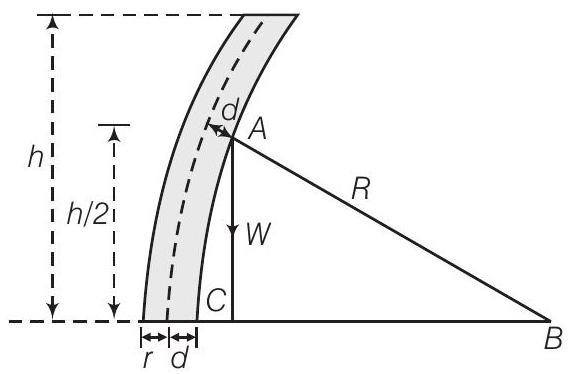
If $\omega_0$ is the weight/volume
$$ \begin{aligned} & \qquad \frac{Y \pi r^{4}}{4 R}=\omega_0(\pi r^{2} h) \frac{h^{2}}{8 R} \quad[\because \text { Torque is caused by the weight }] \\ & \Rightarrow \quad h \simeq(\frac{2 Y}{\omega_0})^{1 / 3} r^{2 / 3} \\ & \text { Hence, critical height }=h=(\frac{2 Y}{\omega_0})^{1 / 3} r^{2 / 3} . \end{aligned} $$
29. A stone of mass $m$ is tied to an elastic string of negligble mass and spring constant $k$. The unstretched length of the string is $L$ and has negligible mass. The other end of the string is fixed to a nail at a point $P$. Initially the stone is at the same level as the point $P$. The stone is dropped vertically from point $P$.
(a) Find the distance $y$ from the top when the mass comes to rest for an instant, for the first time.
(b) What is the maximum velocity attained by the stone in this drop?
(c) What shall be the nature of the motion after the stone has reached its lowest point?
Show Answer
Thinking Process
In this problem ,the given string is elastic and there is no dissipation of energy we can apply conservation of mechanical energy.
Answer Consider the diagram the stone is dropped from point $p$.
(a) Till the stone drops through a length $L$ it will be in free fall. After that the elasticity of the string will force it to a SHM. Let the stone come to rest instantaneously at $y$.
The loss in PE of the stone is the PE stored in the stretched string.
$$ m g y=\frac{1}{2} k(y-L)^{2} $$
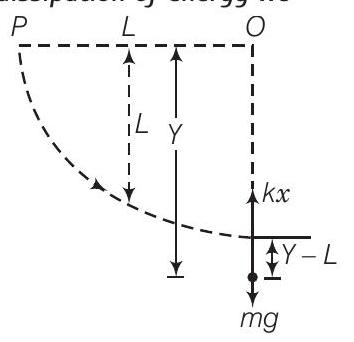
$$ \begin{aligned} \Rightarrow \quad m g y & =\frac{1}{2} k y^{2}-k y L+\frac{1}{2} k L^{2} \Rightarrow \frac{1}{2} k y^{2}-(k L+m g) y+\frac{1}{2} k L^{2}=0 \\ y & =\frac{(k L+m g) \pm \sqrt{(k L+m g)^{2}-k^{2} L^{2}}}{k}=\frac{(k L+m g) \pm \sqrt{2 m g k L+m^{2} g^{2}}}{k} \end{aligned} $$
Retain the positive sign.
$$ \therefore \quad y=\frac{(k L+m g)+\sqrt{2 m g k L+m^{2} g^{2}}}{k} $$
(b) In SHM, the maximum velocity is attained when the body passes, through the “equilibrium, position” i.e., when the instantaneous acceleration is zero. That is $m g-k x=0$, where $x$ is the extension from $L$.
$\Rightarrow$
$$ m g=k x $$
Let the velocity be $v$. Then,
Now,
$$ \begin{aligned} & \frac{1}{2} m v^{2}+\frac{1}{2} k x^{2}=m g(L+x) \quad \text { (from conservation of energy) } \\ & \frac{1}{2} m v^{2}=m g(L+x)-\frac{1}{2} k x^{2} \end{aligned} $$
$$ \begin{aligned} \therefore \quad \frac{1}{2} m v^{2} & =m g(L+\frac{m g}{k})-\frac{1}{2} k \frac{m^{2} g^{2}}{k^{2}}=m g L+\frac{m^{2} g^{2}}{k}-\frac{1}{2} \frac{m^{2} g^{2}}{k} \\ \frac{1}{2} m v^{2} & =m g L+\frac{1}{2} \frac{m^{2} g^{2}}{k} \\ \therefore \quad v^{2} & =2 g L+m g^{2} / k \\ v & =(2 g L+m g^{2} / k)^{1 / 2} \end{aligned} $$
(c) When stone is at the lowest position i.e., at instantaneous distance $Y$ from $P$, then equation of motion of the stone is
$$ \frac{m d^{2} y}{d t^{2}}=m g-k(y-L) \Rightarrow \frac{d^{2} y}{d t^{2}}+\frac{k}{m}(y-L)-g=0 $$
Make a transformation of variables, $z=\frac{k}{m}(y-L)-g$
$$ \therefore \quad \frac{d^{2} z}{d t^{2}}+\frac{k}{m} z=0 $$
It is a differential equation of second order which represents SHM.
Comparing with equation $\frac{d^{2} z}{d t^{2}}+\omega^{2} z=0$
Angular frequency of harmonic motion $\omega=\sqrt{\frac{k}{m}}$
The solution of above equation will be of the type $z=A \cos (\omega t+\phi)$; where $\omega=\sqrt{\frac{k}{m}}$
$$ y=(L+\frac{m g}{k})+A^{\prime} \cos (\omega t+\phi) $$
Thus, the stone will perform SHM with angular frequency $\omega=\sqrt{k / m}$ about a point $y_0=L+\frac{m g}{k}$.










